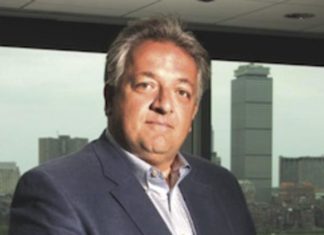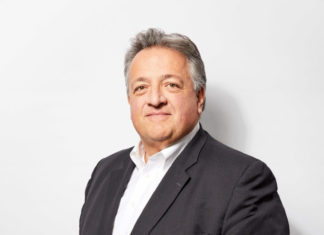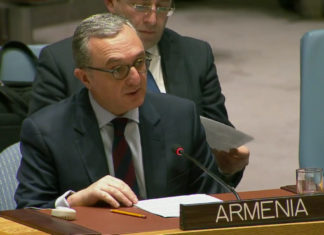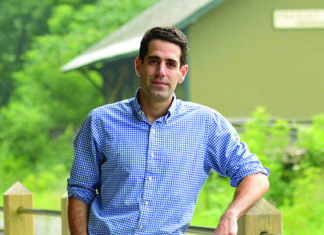Lesley University and Violence Transformed Hosts Presentation of Art on the Armenian Genocide
By Aram Arkun
Mirror-Spectator Staff
CAMBRIDGE, Mass. – Lesley University of Cambridge together with the Violence Transformed program hosted an exhibit of paintings and artist talks on the evening of March 9 called “The Future of the Past: A History Ignored – Honoring the 100-Year Anniversary of the Armenian Genocide through Art and Dialogue.” The works of artists Hope Metcalf Ricciardi, John Avakian and Marsha Odabashian, and (in a separate area) Adrienne Der Marderosian were exhibited. The first three came to speak about their attempts to derive meaning through art of the intergenerational trauma of the Armenian Genocide and its continued denial. The exhibit was on display from March 6 to March 16. The curators of this exhibition were Ricciardi, Nancy Beardall and Meenakshi Chaabra.
The event began with a musical introduction. Violinist Drew Ricciardi, son of one of the artists, performed “Élégie” by Igor Stravinsky. Catherine Koverola, dean of Lesley University’s Graduate School of Arts and Social Sciences, welcomed the audience. She explained that this was the second annual event the university held together with Violence Transformed. The evening represented “giving voice to those who are silent.” In particular, there are many genocides that have happened and are happening, but in the Armenian case, the world stood silent. Koverola asked whether today we will stand silent with what is happening in the world. She hoped that shared humanity in honoring the past will also lead people to think about the future.
Koverola then introduced Dr. Mary Harvey, a psychologist and clinician who is the founding director of Violence Transformed. Violence Transformed is an annual Boston-area series of art events that “celebrate the power of art, artists and art-making to confront, challenge and mediate violence.” It was started in 2007. Harvey mentioned that she introduced John Avakian to the term “intergenerational trauma” after meeting him through a class. She spoke about the work of Violence Transformed, and concluded that “the future of the past in my judgement is memory. The future of the past is always going to be what we remember or what we refuse to remember. Tonight is about not refusing to remember.”
Associate Professor Meenakshi Chhabra of Lesley University’s Interdisciplinary Studies (Peace and Conflict Studies) and International Higher Education and Intercultural Relations programs, then thanked those who helped make the event possible. She said that each year the hope was that through such events “to engage in conversations about vision and transformation through the arts.” This is a commemoration of the hundredth anniversary of the Armenian Genocide which she wished would not only make people understand the Genocide, but to “inspire us to think about the larger questions of how do we respond to these crimes against humanity, and the role of acknowledgment, denial and memory in restoring these narratives of genocide and violence and also the role of the arts in envisioning possibilities for the future.” Chhabra concluded with the famous quote from William Saroyan about no one being able to destroy the Armenians, for when two meet anywhere in the world they create a new Armenia.
Ricciardi was the first of the artists to speak. She is a graduate of the School of the Museum of Fine Arts in Boston and Tufts University and teaches and directs art programs in addition to working in her studio. She specializes in early childhood education. Ricciardi is represented by Galatea Fine Art of Boston, Mass. She is also the Coordinator of Performing Arts for Violence Transformed.
Ricciardi came up with the idea for this evening over a year ago during coffee with Adrienne Der Marderosian. Mary Harvey invited them to hold it through the Violence Transformed program.
Relatively late in life, Ricciardi began to investigate her Armenian background. She had always previously been led to believe she was Anglo-Saxon, as her paternal grandparents never talked about her grandfather’s background. He had left Adana in 1906. Her artistic work since 2008 became inspired by what she learned. Her works include oil paintings on linen, panels or canvas; drawings which are block print ink on various types of paper; and installations of drawings with sculptures created in the form of khachkars or Armenian cross stones.
Ricciardi showed slides of her works and explained their significance, beginning with “A History Ignored,” a 5-panel pointillist version of a deportation or death march. She plans to explore more about the heroism of the Armenians during the Genocide by traveling to Turkey and Armenia.
Martha Nouritza Odabashian spoke next, again showing slides of her works. She began with her piece called “Elegy.”
The grandchild of Armenian Genocide survivors who immigrated to the US, Odabashian studied at the University of Wisconsin at Milwaukee, the University of New Orleans, the Art Students’ League in New York, and the School of the Museum of Fine Arts/Tufts in Boston, from which she received a Master of Fine Arts degree. She teaches elementary art in the Westwood public school system in Massachusetts, and has taught drawing courses at the School of the Museum of Fine Arts in Boston.
The third speaker, printmaker John Avakian of Sharon, Mass., received his bachelor’s and master’s of fine arts from Yale University, and teaches at the School of the Boston Museum of Fine Arts, as well as Northeastern University. He has several collections at the Fogg Museum Print Department, the New York Public Library Print Document, and the Boston Public Library Print Department. His piece “Anatomy of a Genocide” was included in the 2003 North American Print Biennial Exhibition of the Boston Printmakers, and won the Legion Paper Award. His talk was a very personal take on the transmission of the trauma of the Genocide.
The fourth artist in the exhibit, Adrienne Der Marderosian of Belmont, Mass., received her bachelor’s degree from Tufts University and studied at the School of the Museum of Fine Arts in Boston. She has exhibited her work at academic venues, and has pieces in museums like the Danforth Museum in Massachusetts and the Hammond Museum in New York.
A question and answer session was followed by a reception. The audience comprised approximately fifty people.
Lesley University and Violence Transformed Hosts Presentation of Art on the Armenian Genocide
Top 5 Articles
- Trending
- Most Viewed
- Most Commented
- US and European Aid Package to Armenia Is Not Only Cheap, It’s Dangerous
- Fresh Lavash and Armenian Delights at Gyumri in Watertown
- Recipe Corner: The Gutsy Gourmet’s Armenian Eech
- Why Is the Biden Administration Whitewashing Azerbaijan’s Crimes?
- Major Ethiopian Exhibit Comes to Massachusetts Including Armenian Artifacts
- US and European Aid Package to Armenia Is Not Only Cheap, It’s Dangerous
- Valerian Markarov: Writing Russian and Being Armenian in Georgia
- California Armenian Legislative Caucus Foundation Announces Scholarships in Remembrance of the Armenian Genocide
- Recipe Corner: Kohar Avakian’s Cherished Family Recipe for Tutum
- Recipe Corner: Zatiki Chorek: Armenian Easter Bread
- Why I Am Grateful to Erdogan, the Dictator of Turkey
- A Political Whirlwind Engulfs Nagorno Karabakh
- Libya’s Interim Government Recognizes the Armenian Genocide Once Again
- Robert Bedrosian Marries High Tech With Ancient Armenian Manuscripts
- Aleppo Aid through St. Kevork Armenian Apostolic Church of Houston








